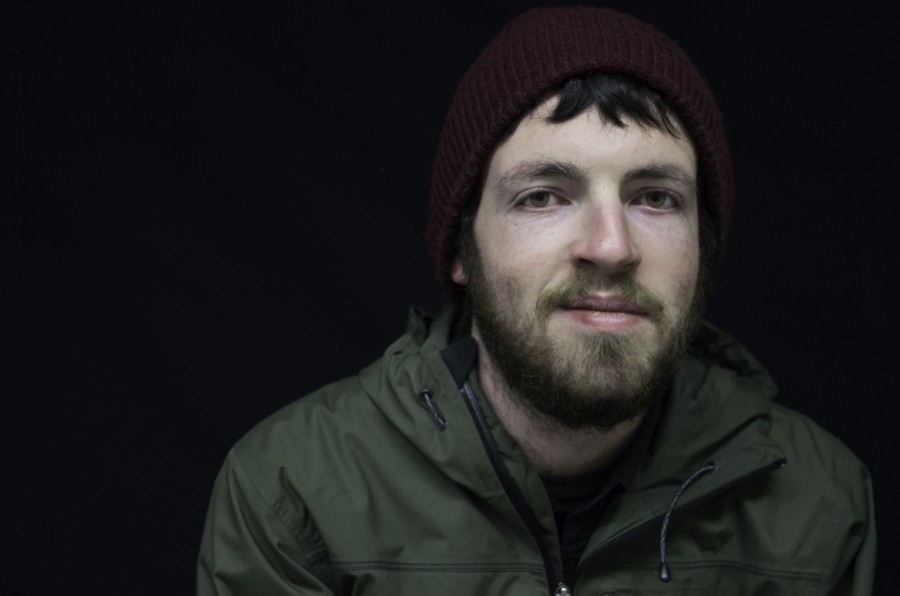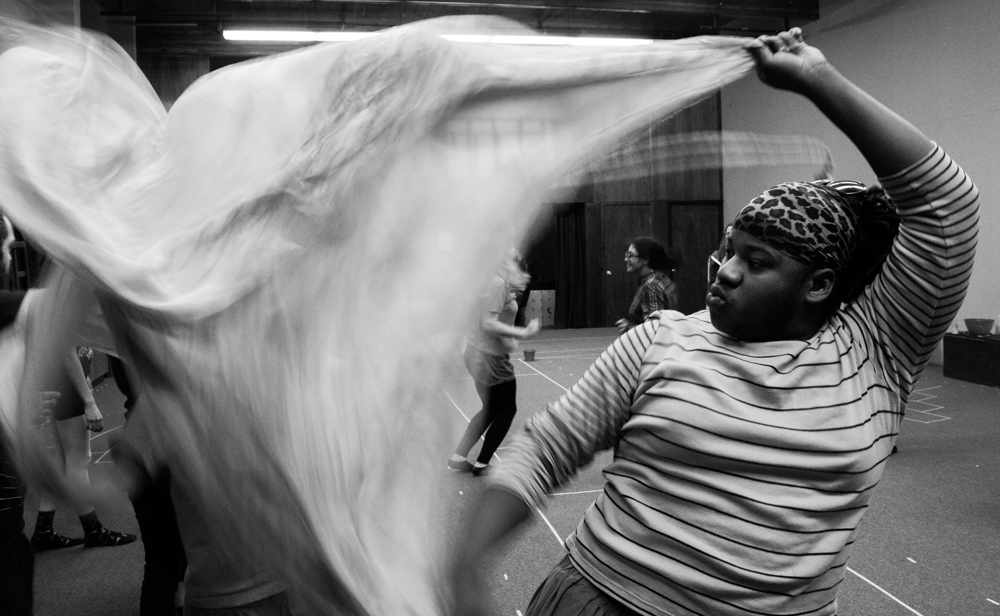Story by Brandon Ghigliotty/Photos by Shayla Blatchford The main lobby of the Thaw Art History building greets me with a faux bathroom. In place of a mirror, a screen plays looped video above its sink. The installation crowds the main lobby and forces visitors into the rest of the building. A large piece beckons at the end of the hallway, a many doored wooden box around five feet tall—its flanks draped in black cloth. Rusty hinges flex while the apparatus behind it ticks and strains. The work in the hallway, part of a joint exhibition entitled Range that will be shared with Universidad del Mar in Chile, continues past the restrooms with the sketch of a tree trunk. The illustration’s color defies the verdant nature of the piece, with its bruised, purple coloration exacerbating the veins of the tree’s trunk. While examining the piece, a figure approaches from my peripheral vision. I shift my weight and scoot out of her way, greeting her. She nearly passes before I recognize her: Linda Swanson, chair of the art department. I begin to introduce myself, but I’m interrupted by her. “If you want to talk, you’ll have to keep up,” she says. I roll to the balls of my feet and spring up after her as she strides down the passageway. Photographer Shayla Blatchford and I follow Swanson to the building’s kitchenette. She multi-tasks while speaking to us. Swanson punches the microwave and trades out mugs, before she splits tubes of instant coffee over them. She tells me about a recent event within the Art Department. Santa Fe University of Art and Design’s Kristaan Villela, who holds a doctorate with an emphasis in Pre-Columbian Art, hosted a lecture on the role of the Apocalypse throughout mankind’s history. The...
Breaking Barriers
posted by Arianna Sullivan
Story by Arianna Sullivan/Photo by Natalie Abel “Really,” says Tony O’Brien earnestly, “enjoy the photography. Be who you are.” The Santa Fe University Photographic Society meeting is still for a moment, digesting, and then works itself back up into the excited planning frenzy that preceded Tony’s statement. “So what are we photographing,” inquires one student eagerly, “the people, the streets, of just everything?” Tony looks at the array of confused, enthused and jittery faces and responds simply, “as you see it.” The group has gathered to discuss the Santa Fe Grid Project—the photo department’s plan for involvement in this year’s Outdoor Vision Fest. Outdoor Vision Fest is an annual outdoor art show of design, animation, video, photography and other visual imagery, and the photo department is preparing to be a larger and louder presence in 2013 than it has been in past years. The project that the photo department has decided to embark upon, the Santa Fe Grid Project, has potential to grow in influence beyond the festival and even the campus as well. The Grid Project, brainchild of Photography freshman Chris Beran, will be a photographic documentation of Santa Fe’s neighborhoods by SFUAD Photo Society members. Photo students from the school will document designated neighborhoods of the city by means of whatever photographic medium speaks to them—be it still image, analog or digital, time lapse, alternative processing, with or without the accompaniment of interviews or music—as Tony O’Brien puts it, “as you see it.” Both Chris Nail and Tony O’Brien, the faculty members heralding the Photo Department’s involvement in OVF 2013, are enthusiastic about the project’s potential to be the beginning of a continued relationship between SFUAD and the city of Santa Fe. “It will be a living document, a sort of micro-version of the documentation that occurred during the American Depression,” explains Chris Nail, “an evolving picture history of the city.” Tony O’Brien brings attention to the gap that usually exists between universities and the cities they are planted in, with a hopeful sense that this project could bridge that gap between the Santa Fe community and the Santa Fe University. If the project is repeated every year as a sort of series, O’Brien explains, the relationship would be symbiotic—the students would be given an opportunity to extend their tromping grounds beyond the school campus, meanwhile providing a sort of service to Santa Fe. This hope is mirrored by the enthusiasm of the students already involved in the project. Chris Beran, who got the idea for the grid project from a similar one in Portland, says that he’s inspired by the opportunity to give back to the community in an artistic way. “Community service is awesome,” he says, “but it’s kind of generic. But if you can use your skills and really put time and effort into something and give it back with that—to me, that’s priceless.” Chris is aware that there are challenges to large-scale community oriented projects like this, but he is confident that the artistic drive behind each photographer will carry the project forward. “It’s just a matter of finding the time, getting out there, and doing it,” he says enthusiastically. The reality of this hits home as, back at the Photo Society meeting, students begin to chart out the neighborhoods they will be documenting—first with a calling out of street names accompanied by exuberant hand gestures, and then more concretely with a map of the city in front of them. Confusions arise, and the largeness of the project sinks in; “Oh- saj? Where the hell is oh-saj?” asks one student, mispronouncing the street name. Laughter resounds, and somebody chirps up, “I think it’s called Osage.” “Wow,” exclaims another, somewhat startled student, viewing her neighborhood on the map for the first time, “that is a huge chunk of Alameda!” Tony and Chris eyeball each other with eyebrows raised, all too aware of the reality...
The Story of Water
posted by Luke Montavon
Story and photos by Luke Montavon Since last fall I have been following Victor Talmadge and his documentary theater class on their journey to create the show Water. Water is the story of a little known Santa Fe village of Agua Fria and its ultimate demise, as it lose its most precious resource to the city. However the story is not only about what happens when a community loses a resource, but also how the community members celebrate having a resource. The following images reflect the first 20 minutes of the play, how we celebrate having water. Talmadge’s students have created a symbolic, cross-cultural journey, with the use of silk cloth to reflect this...



 Jackalope Magazine is the student magazine of Santa Fe University of Art and Design. Building on the interdisciplinary nature of our education, we aim to showcase the talent of our university and character of our city.
Jackalope Magazine is the student magazine of Santa Fe University of Art and Design. Building on the interdisciplinary nature of our education, we aim to showcase the talent of our university and character of our city.
Recent Comments